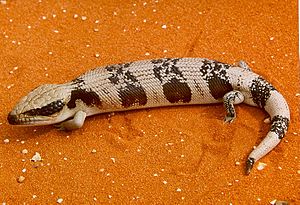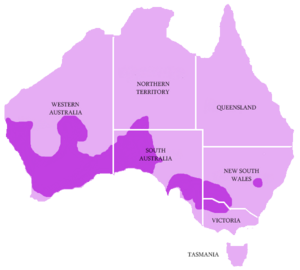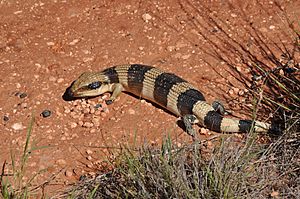Western blue-tongued lizard facts for kids
Quick facts for kids Western blue-tongued lizard |
|
|---|---|
 |
|
| Conservation status | |
| Scientific classification | |
| Genus: |
Tiliqua
|
| Species: |
occipitalis
|
 |
|
| Range indicated by darker shading | |
The western blue-tongued lizard (Tiliqua occipitalis), also called the western blue-tongued skink, is a large skink that lives in Australia. It is one of six types of blue-tongued skinks found in Australia. Other types live in New Guinea and Indonesia.
Contents
Where Do Western Blue-Tongued Lizards Live?
The western blue-tongued lizard mostly lives in Western Australia. You can find a few in the far south of the Northern Territory. In South Australia, they are split into two groups: one in the east and one in the west.
What Does a Western Blue-Tongued Lizard Look Like?
These lizards can grow to about 45 cm (18 in) long. They have a brown body and tail with stripes. Their belly is usually light in color. They have special black marks behind each eye. Their body is wide and big compared to their short legs. Just like their name says, they have a bright blue tongue! This blue tongue stands out against the pink inside of their mouth.
What Do Western Blue-Tongued Lizards Eat?
Western blue-tongued lizards are active during the day. They hunt for insects, spiders, and snails. They also look for plants, especially berries, and eat dead animals. They are not very fast, so they usually catch slow-moving prey. Their strong jaws help them break open snail shells and the hard outer shells of beetles.
They live in places like grasslands, sand dunes, shrublands, and thin woodlands. At night, they rest under leaves or rocks. Sometimes, they use old rabbit burrows to stay safe.
How Long Do Western Blue-Tongued Lizards Live?
Blue-tongued lizards are popular pets and can live for up to 30 years when cared for by humans. However, the western blue-tongued lizard is quite rare as a pet because it's one of the less common types.
Female lizards usually give birth to about 5 live babies. The young lizards eat the special membrane (like a thin skin) right after they are born. They are quite developed at birth and can move around on their own after just a few days. Young lizards have yellow and brown stripes on their bodies and tails.
What Dangers Do Western Blue-Tongued Lizards Face?
The western blue-tongued lizard is considered "Near Threatened" in Victoria. This means their numbers are getting low there. They are "Threatened" in New South Wales.
Some dangers to these lizards include:
- Being hunted by animals like the red fox and domestic cat, which were brought to Australia.
- Their homes being cleared for farms.
- The destruction of rabbit burrows, which they use for shelter.
When a western blue-tongued lizard feels scared, it might open its mouth wide and stick out its blue tongue. This is a warning sign! If that doesn't work, and the danger doesn't go away, it might hiss and flatten its body. This makes it look bigger and scarier to try and scare off predators.
Who Are the Relatives of the Western Blue-Tongued Lizard?
The western blue-tongued lizard is related to the Tiliqua scincoides scincoides, also known as the eastern blue-tongued skink.



